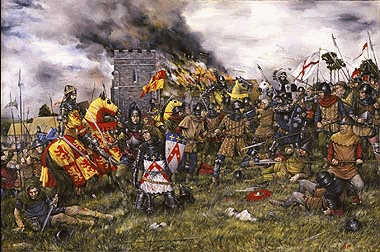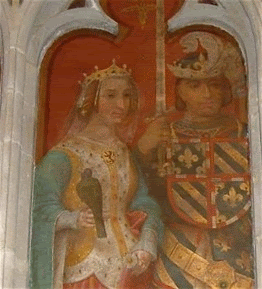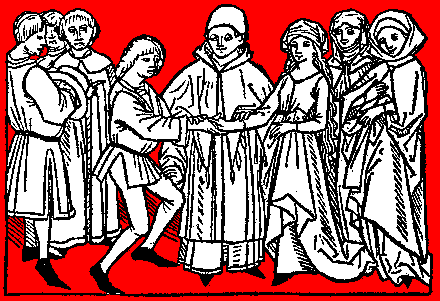Chronicles of De Bourgogne
The story of the House of De Bourgogne presents a fascinating example of medieval power politics, family dynamics and timeless drama to any student of the period. From their ranks issued forth all the best and worst aspects of humanity, saints and devils equally a part of the family's history.
The family's origin is wrapped in the fate of Robert Capet, the son of King Henry II of France. Plagued by rebellious vassals, Henry soon found his own sons arranged against him in the conflict. Despite the death of his eldest brother, Robert and his brothers defeated their father and Robert was given the newly won duchy of Burgundy to rule in 1032 while his other brother Henry ruled France.
Artist depiction of Henry's sons in their rebellion
Still a young man after his success, Robert began a reign of brigandage and plundering that laid waste to the territory placed in his care. His vassals followed his lead and there is little doubt that these days were terrifying for the populace of his domain. The church was a favorite target for his attacks.
Medieval record of Robert attacking a fortified manor
His married life sheds more light on his dysfunction. He repudiated his first wife in 1055 despite having several issue and even went so far as to murder her father, reportedly by his own hand. His second marriage, to a daughter of the Duke of Anjou, seems to have been less violent.
Robert, Duke of Burgundy and his second wife Ermengarde of Anjou
As time passed, Robert grew less inclined to raid and plunder the surrounding areas. None can truly say why this was, but it is due to this fact that more extensive records of the duchy begin in 1067, over thirty years after he first gained control over the area.
Evidence from these records show that Robert was directly in control of the Dijon and Charolais areas of modern southeastern France. In addition, he was the direct overlord of three petty counts, those of Nevers, Macon and Chalons. Despite his excesses, these provinces were reasonably prosperous and provided the Duke with a strong presence in comparison with the surrounding region.
Marriages amongst the nobility were, of course, an important event in medieval times. The maze of specific claims and descent played a critical role in determining a family's fortunes and future prospects. Contracts and statements from 1067 reveal that the Duke negotiated that his son Simon be married to one of the Count of Limousin's daughters while his own daughter Hildegarde was delivered to the Count of Amiens. Mentioned as being a superb soldier, the Duke's son Robert was also married to a minor noblewoman from the Duchy of Aquitaine near the same time.
Marriage of Simon and Humberge
Knowing that his crude way of ruling and previous actions had decreased his stature in the eyes of other rulers, Robert sought to remedy the situation by appointing his eldest son Henri, another noted warrior, as his coruler in Dijon.
The result was satisfactory, as other records note the rise in presitge associated with the move.
In an effort to raise revenues in his holdings near Charolais, the Duke supported the establishment of camps to cut the numerous forests of the region. It is reported that conditions at these forestries were severe, with the Duke providing only the bare necessities for the workers in their effort.
The year 1068 brought a series of unsuspected, yet not unwelcome events. The new King of France, Phillip I, rose to his majority and approached the Duke for his daughter Constance in marriage. Historians have credited the move to an attempt to secure the Duke's loyalty for the description of Constance's personality leaves much to be desired. The Duke himself saw the situation as ripe for his own advancement and eagerly agreed to the terms.
Later that year, the Pope called for the lords of Christendom to raise arms against the eastern infidel. the messenger sent to the Duke was dismissed out of hand, for the Duke had never been a religious man and saw no profit in traveling away from his holdings. Phillip, fired with youthful energy and zeal, eagerly accepted the invitation and began to gather regiments for his adventure against the Kingdom of Egypt. He soon departed across the Mediterranean.
King Phillip on Crusade
Improvement continued in Charolais during this period, with a series of royal post stations being spread over the territory. The merchants of the province, happy at this development, approached the Duke and asked for his support in establishing city laws as superior to canon law. Robert, having no love for the church, quickly accepted in return for monetary inducement.
The next event to impact the Bourgogne family was a feast held to honor the conclusion of a great hunt. The Duke, more confident than ever in his position , is said to have acted quite haughtily in the presence of his vassals and surrounding counts. He dressed in full regalia during the supposedly casual dinner and stood as the life of the party, holding no topic sacred. The records from their territories reveal that his display impressed quite a few of these guests and that the Duke's stock in their eyes improved as a result.
Robert, Duke of Burgundy and his sons at a feast
Proving that his old ways were not entirely out of his system, letters exist that point to an illicit relationship between the Duke and his son Robert's wife, Constance. Confirmed as being in the Duke's own hand, these papers are strong evidence that the Duke had had a falling out with his wife and had sought out the young bride as a source of carnal entertainment.
In 1069, another flashpoint in family politics presents itself. During a tourney being held in the Count of Chalons demesne, Henri, the King's eldest son and de facto ruler of Dijon, supposedly snapped at his father and upbraided his behavior regarding Robert's wife. Hardly one to take such behavior, the Duke immediately threatened to purge his son of his title and disinherit him forever. Whatever Henri's personal qualities, he could not risk such a outcome and humbly begged for forgivness before an assembled court. After much consideration, the Duke was won over by arguments from his family and accepted the apology.
It was not long after this event that, in may of 1070, the Duke died. He was succeeded by Henri and interred near his estate near Dijon since no churchyard would take the body. Leaving behind a brutal legacy, the rule of Robert I would be a memory most in Burgundy would wish to forget.
Thank you very much for reading my AAR, please comment!!! As this is my first writing, let me know what it is you would like to see. More pictures, maps , diary entries are only a kind suggestion away. Thank you once again.








